Ruth Soukup's Blog, page 58
August 8, 2016
The Magic of Thinking BIG

Every morning at 4am, while the rest of the world is still asleep, I head out for my morning walk. And while that might sound like torture to many people, it’s actually my favorite part of the whole day, the time where the whole world is just mine. It’s my time to think and dream and listen to audiobooks and make sense of the world, to get purpose and clarity on who I am and where I am going. And I wouldn’t give it up for anything.
Lately I’ve been doing a lot of thinking about goals and motivation and why some people are able to achieve the things they want, and others seem to just sit there making excuses, worrying about all the things that could go wrong, or waiting for circumstances to be perfect.
And I think it comes down to how bad you really want it.
You see, when you want something, I mean really want it, you can feel it in every bone in your body, that drive, that hunger, that internal pressure to achieve. You don’t need anyone else to push you—you’re more than willing to do whatever it takes. And it doesn’t feel like work, either. Oh sure, there might be hard days and annoying moments, but they are worth it because every step you take is getting you closer to that goal.
And if you don’t feel that? Then maybe your goal isn’t big enough.
When I first started this blog, Living Well Spending Less, I set a goal for myself to make enough money blogging that my husband—an aerospace engineer—could quit his job and become a stay-at-home dad. At the time, it was a completely crazy goal that seemed utterly impossible, and my husband told me as much, insisting that I would never be able to make money from a blog.
But I wanted it so bad, I could almost taste it, and I was determined to do whatever it took to make that crazy dream a reality.
And so, with two toddlers at home, I started getting up at 3am every morning—and often even earlier—in order to work on my blog before anyone else was up. I took advantage of every naptime, every weekend, and every spare moment. And when I wasn’t working on the blog itself, I was learning everything I could about the business of blogging, from SEO to social media to how to actually generate revenue.
I’m not going to lie, it was a pretty exhausting time. There were lots of downsides. My husband couldn’t understand why on earth I was spending all my time on a blog that he was sure would never amount to anything. My real life friends laughed at me to my face and talked about me behind my back. My kids watched way too much Dora the Explorer and Wildcrats. I didn’t get nearly enough sleep. I had almost no life. And even though it was hard, to me the effort was worth every sacrifice, because I could see the vision of what this blog could be, even if no one else could at the time.
In 2013, nearly three years after starting this blog, that dream became a reality. My husband was able to quit his job and we’ve never looked back. The blog—and the full-fledged business that has grown out of it—has continued to grow and flourish.
But that’s not the end of the story.
You see, once I actually achieved that crazy big goal, the one everyone–even me–thought was totally impossible, I was left with two very clear choices. I could sit back and coast, or I could set some NEW crazy big goals, new dreams that would keep me hungry and keep me jumping out of bed before dawn every day.
You probably know which one I chose.
Whether you are a blogger or own your own business, or whether you are a working mom or a stay-at-home mom, you might think setting small, reasonable goals is the way to go. After all, small reasonable goals seem safe and, well, reasonable, right?
Wrong.
I am here to tell you that thinking small won’t get you anywhere. For your dreams to motivate you to action, they have to big enough to scare you a little, to ignite that spark of courage and determination that lives inside you.

The Magic of Thinking Big
Have you ever heard of a football coach named Lou Holtz? In 1966, when he was twenty-eight years old, Lou Holtz was going through a serious rough patch. His coaching career going nowhere. He was broke and unemployed. And, to make matters even worse, his wife was expecting their third child.
Something had to give.
Hoping to motivate him, his wife bought him a book called The Magic of Thinking Big by David Schwartz. The book worked. Inspired by what he read, Holtz decided that the key to changing his life was make a list of all the BIG things he really wanted to achieve in life.
His list included some pretty audacious goals, such as becoming the Notre Dame football coach, meeting the president, landing on an aircraft carrier, and appearing on The Tonight Show—CRAZY things that most people would have laughed at him for even considering.
But guess what? Not only did Lou Holtz become the head football coach at Notre Dame, but he also led his team to a National Championship. Among other things, he enjoyed dinner with Ronald Regan at the White House, was a guest on The Tonight Show, met the pope, shot not one but two holes-in-one at golf, jumped out of an airplane, went on a safari in Africa, and yes, he even landed on an aircraft carrier.
To date, Lou Holtz has crossed off 102 of his 107 lifetime goals.
But what people often forget is that as awe-inspiring as Lou Holtz turned out to be, he didn’t start out that way. He was just an ordinary guy full of the same frustrations and failures and self-doubt that we ALL experience sometimes. In fact, at one point his poor pregnant wife was wringing her hands just wondering how to get him off the couch!
But ultimately the difference between Lou Holtz and so many others was that he became not only willing to imagine a better life for himself in the biggest possible ways, he was also willing to write those goals down and make them real. Once he they were real to him, he was able to take the steps necessary to make those goals happen.

Why You Need a Stretch Goal
In his most recent book, “Smarter, Faster, Better,” bestselling author Charles Duhigg explains that while we often hear about the importance of setting “SMART” goals—goals that are Specific, Measurable, Actionable, Realistic, and Time-Bound,” there is an even more critical piece of effective goal-setting-that often gets forgotten.
So what is this critical element?
According to Duhigg, it is starting with what he calls a “stretch goal.” In other words? It is thinking BIG. “The problem with many to do lists,” he explains,” is that when we write down nothing but a series of short term objectives we are only working to satisfy the immediate need for closure.”
He goes on to explain that without a BIG goal to reach for and tell us what to focus on, we will spend hours on unimportant tasks simply because it feels good to check them off our list.
But here’s the thing–the true secret of productivity is being able to focus 100% of your attention on your biggest, most important tasks at any given time.
And while that sounds so simple, I’ve discovered that for most of us, it’s not. There are a few big obstacles that get in our way. We don’t know what the most important task is. We are too distracted. We are afraid we might miss something.
But all these obstacles point to one larger problem, and that is that we don’t have a BIG plan for success. Instead of thinking BIG and allowing ourselves to consider—and shoot for—the wildest possibilities, we think small, allowing ourselves to get mired down in the day-to-day grind.
We tell ourselves there is too much to do to worry about pie-in-the-sky ideals; that it is more important to worry about where our next paycheck is going to come from than what our retirement plan will be.
But busy is not the same as productive.
And so before we can figure out how to focus 100% of our attention on our biggest, most important tasks, we need to give ourselves permission to think BIG.
The reality is that big goals get big results, while small goals get small results. What you will become is what you believe you can become, and the bigger and scarier your goal, the more chance you will have for big success.
Big goals are the road map for our lives that tell us what direction we need to go. They are the compass that keep us on the right path. They are the filter that lets us know what is important and what is not worth our time. Big goals are the key to success.

Overcoming Your Limiting Beliefs
So what holds us back from setting—and therefore achieving—these big goals? Almost always, it is something known as a limiting belief—a thought or belief we have about ourselves that holds us back from achieving our full potential.
These limiting beliefs can come in all shapes and sizes, and appear in all different areas of our lives. They are also shape shifters—re-emerging in a new way each time we think we’ve overcome one. Most of us have many limiting beliefs, but I believe that all of us have at least a few.
It might be that we don’t believe that we actually have anything valuable to offer the world, or that we aren’t as talented or witty or well-spoken as so-and-so. It might be that we don’t believe we can actually accomplish those things that we’ve thought about doing, or that we’re not smart enough to be successful. It might be that we don’t want to invest in ourselves because we might fail. It might be that we don’t want to reach out and ask for help because we might get rejected. It might be that we don’t want to put 100 percent of our energy and efforts into a new project because we’re not sure what the people around us will say. What if they don’t understand? What if they make fun of us?
Whatever your limiting beliefs may be, I guarantee they are there. And while we can’t always stop those limiting beliefs from popping up, we CAN refuse to listen to them. Because once we’ve recognized a limiting belief for what it is—just a thought that is holding us back—we can take away the power it has over us and move past it.

Conquering the Fear of Failure
I think that the biggest limiting belief that most people have is the fear that they might fail. Because let’s face it—none of us want to fail! And often that fear that we might make a mistake or a misstep, that we might fall flat on our face or lose all the time or money that we’ve invested becomes completely paralyzing.
And our response to that fear is to pull in, to get smaller, to try to mitigate the potential risk by not doing too much in any one area. We dabble a little here and a little there, ever dipping our toes into the water, never wanting to go all in.
The results from this strategy range from minimal to moderate success. There is no big failure, but there is also no big success.
Here’s the thing—it is really easy to look at the most successful people and assume that they have always been successful, or that everything they touch turns to gold, or even that they were just born lucky and happened to be in the right place at the right time. But in reality, this is very rarely the case.
Even the most successful people have experienced—and continue to experience—failure. That is the nature of entrepreneurship—some risks will pan out and others won’t. They key is usually to learn from your missteps and to not let a few setbacks stand in your way.
Michael Jordan once famously said, “I’ve missed more than 9,000 shots in my career. I’ve lost almost 300 games. 26 times, I’ve been trusted to take the game winning shot and missed. I’ve failed over and over and over again in my life. And that is why I succeed.”
Likewise, Thomas Edison had to try 10,000 versions of the light bulb before he finally figured out what would work.
Steve Jobs was actually fired by the board at Apple at one point. He later said that it was the best thing that ever happened to him, because it spurred more creativity and more ideas than he had ever had before.
Most people don’t know that Henry Ford actually founded two failed motor companies before finding huge success with the Ford Motor company and the Model T.
Bill Gates’ first startup company, Traf-O-Data, was an abject failure. The product barely even worked & the endeavor was a complete disaster. However, that failure taught him some very valuable lessons that he was able to apply when he started his new company, Microsoft, a few years later.
One of my favorite quotes of all time is from Winston Churchill who said, “success is not final, failure is not fatal, it is only the courage to continue that matters.”
While failure isn’t fun to think about, I don’t want that fear of failing to be what holds you back from thinking big. The reality is that you will make mistakes. Everyone does. Think big anyway.
In my own life, I have certainly experienced my share of failures, mistakes, bombs, and missteps. My first marriage ended in divorce. I dropped out of law school. I got fired. I filed for bankruptcy. I trusted someone I shouldn’t have, only to have the situation blow up in my face. Even in my business, I have hired the wrong people, made giant mistakes, and invested in projects that have been nothing but big money losers.
But I’ve also learned that this is just part of life. If I spend my time beating myself for the mistakes I make, I won’t have any time to focus on the things that are going well. Being successful in life is all about learning to think BIG in order to maximize your success.

Setting Your Big Goals
When setting your big goals, don’t be afraid to start with a grand vision—a life list, similar to the one that Lou Holtz came up with after reading The Magic of Thinking Big. To help you focus, try dividing it into different categories—family, financial, professional, and personal.
As you let yourself dream about the future in these different areas, be conscious of the limiting beliefs that begin creeping in to your thoughts. Recognize them for what they are—limiting beliefs—and allow yourself to write down even the craziest, most audacious goals and dreams without judgment or self-editing. Don’t worry either about setting time limits or making them perfect—just write whatever comes to mind.
In other words? Think BIG.
And so, my question for you today is this: how bad do you want it? Are you reaching for a dream so big it scares you? And if not, why not? Push yourself to make it bigger until you feel that spark, that hunger, and then you will know you’re on the right track.
P.S. If you are ready to CRUSH your goals this year, then be sure to preorder your copy of the Living Well Planner. It is designed to help you think BIG, and to help break down those BIG goals into manageable, bite-sized pieces. It features our exclusive Goal Crushing™ framework, and even comes with access to our Crushing It Bootcamp, which will show you how to maximize your time and get the most use out of every section. Reserver your copy by August 31st to save $6 off the cover price!

Pin It
The post The Magic of Thinking BIG appeared first on Living Well Spending Less®.
August 5, 2016
10 Ways to Save on Back to School

Is it just me, or does it always feel like our finances get stretched a little tighter this time of year? Not only are we faced with paying off all that summer fun–all those little excursions sure add up–we’re ALSO hit with the back-to-school “expense bus.”
You know the drill…
It starts with that dreaded list of school supplies we’re expected to buy. Even when we plan for it, those little necessities can pack quite a budget punch! It seems like every year schools, which are often faced with tight budgets, yet offering more technology, arts and other programs, require parents to provide more and more supplemental supplies. And while we all want the best for our kids, the reality is that it can get really expensive!
And school supplies are just the beginning.
We pull out the uniforms and school clothes, only to realize our children hit major growth spurts over the summer and don’t fit into anything they previously wore. Our kids will need haircuts and new shoes as well—all adding to our already stretched budget.
Then there’s Back to School Night. We’re looking at another $20 for the PTO, $25 for the monthly giving program, $40 for after-school clubs, and $8 (or “suggested donation”) for the parent directory. Plus, both kids’ classes will be going on fieldtrips the first week of school—one is $15 and one is $12. And then we get the link to the teacher’s Classroom Wish List on Amazon, in case we’d like to purchase some items, which we know they desperately need.
By the time school starts, we’re literally hundreds of dollars over budget, and feeling exhausted (yet still guilty) because we realize teachers will still end up paying for supplies out of their own pocket.
We’ve all been there. Back to school time is exciting and filled with anticipation and joy, but it can also be one of the most expensive times of year. So, how can a budget-minded parent plan and survive—even thrive—during this time?

1. Go Through Your House
Go through your desk, your office and your kid’s art supplies. Chances are high you have a myriad of supplies ready to go already. I know it’s hard to think your child might not have a shiny new box of crayons to start out the year, but I’m betting they won’t even notice if you don’t see it as a “big deal.”
Instead of lecturing how you’re going to save money by using what you already have on hand, make it fun and more of a “hunt” for all the things they’ll need for school. Pull out last year’s items, clean them off, sharpen them and spruce them up.
When it comes to clothing, let go of the idea your child needs a whole new wardrobe to start school each year. Back-to-school shopping is a cultural phenomenon, but it’s one that doesn’t need to be seen as the norm. Let down hems and patch up anything that has a little wear and tear. Let go of the stigma about hand-me-downs. Instead, view it as an exciting way to shop your sibling’s closet!
2. Talk to Friends
Back to school is prime time to talk to your mom network, via social media, at church, or at the office. Find out if moms have similar sized items, last year’s graphing calculator (that’s no longer needed), or backpacks their child has outgrown. Offer to have an exchange or a day where everyone brings their stuff and does some swapping!
Don’t forget to ask your fellow parents for other tips and tricks as well. Can you go in together and split the cost of certain items. Or, if someone has a warehouse membership, can they purchase 18 boxes of tissues and you can split the pack? It’s nearly always cheaper to buy certain items in bulk.

3. Shop Around
There are tons of bargains at the dollar store and the local discount shop. Check the front-of-the-store bins for dollar deals and don’t forget your supermarket. Aldi and other grocery store chains might have special items on hand, which can certainly help you cut some of those lunch costs.
Break from convention when it comes to food as well. Kids enjoy having a bunch of dip-able items (rather than a regular salad) or a “build your own Lunchable” rather than the same old sandwich. You can also give our DIY PB & J Uncrustables a try. If you have a thermos, you can send hot leftovers that will stay plenty warm until lunch. Freeze baggies filled with damp kitchen sponges for DIY ice packs that can keep things cool.
4. Sign Up for Sale Lists
Everyone is thinking “back to school” and sales abound. Use couponing techniques, just as you would in your weekly shopping. Sign up for the store’s email lists and text alerts, collect ads, and watch for Groupons, Brad’s Deals, and other sites that offer price alerts.
When you do shop online, use services like eBates and always search for a coupon code to cover shipping. Watch for quality when you’re buying items like school uniforms. While you might pay a few dollars more, better quality can mean the difference between a blouse that lasts all year and one that will fall apart by Christmas vacation.
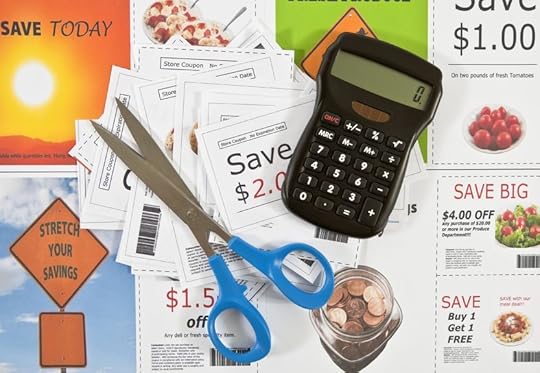
5. Use Coupons
When you look through fliers, mark and clip coupons. Combine them and stretch them as much as possible. If you’re new to couponing, back to school time can be a great way to start. There are many sales happening on small items. You’ll be amazed at how much you can save, especially with back to school deals. Also be sure to check and see if your state offers tax-free days for back to school shopping.
6. Stagger Your Costs
Blown away by the influx of charges at the beginning of the school year? Be candid with teachers and administrative staff. It’s perfectly normal to ask if you can wait to buy a directory until next month (they won’t sell out) or join the PTO by paying half now and half your dues later.
It can be challenging to say no (and everyone wants to help), but you can scan your classroom’s Wish List and see if there are items you might have on hand or do some scouring on Craigslist and other spots to help out without spending more than you can afford.
When it comes to signing up for your school’s monthly giving program or after-school clubs, let them know you’d love to, but you might have to wait until October or November. If your child has a club or activity they really want to do, ask them to work to earn the money to cover half the cost. Not only will they be more dedicated to attending and value the activity more, but it will teach them the value of working for and earning things they want.

7. Wait for Sales
By mid-September most items go on sale. Retailers are trying to clear out store shelves and prepare for Halloween and the holidays. The other thing to keep in mind is that many classrooms don’t use all of the items on their supply list RIGHT AWAY during the first few weeks of school. Ask the teacher if he or she would mind letting you know if there are a few items you can hold off on purchasing for a few weeks. Most will be happy to candidly go over the list with you and help you separate the must-haves from the can-waits.
8. Look for Gently Used
Shop Goodwill, the Salvation Army, and Consignment shops to see what you can find gently used. These stores sometimes offer a few items that are brand new or still have tags. It can be a great way to find clothing, shoes, binders, accessories, pencil boxes and more.
Shop Craigslist and check rummage sales and yard sales for school items, too. Return the favor by donating outgrown and gently used items or listing them online so other parents can follow your lead and find the items they’re looking for.
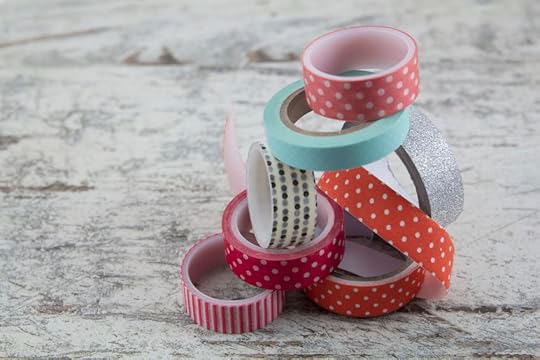
9. Get Artistic
A used binder can become awesome with a little washi tape, some paint stickers and other decorations. Pencils, pens and crayons can feel exciting when they’re housed in a homemade and decorated bag.
If you need ideas on how to revamp shirts, skirts, pants and other clothing items, search for “refashions” online. There are so many ideas to make used and older items new and exciting fashions your child won’t want to wait to wear!
Similarly, invest in some clothing dye and find some cute buttons, embroidery thread and other “bling” to add to your kids’ outfits. You might end up refashioning the whole neighborhood’s wardrobe.
Never underestimate the power of accessories. A headband can help cover haircutting mistakes or styles that need to grow out a little. A cute necklace or bracelet can really make your daughter feel special. You might not need to purchase a new bag or lunchbox if you can add some cool sports team patches or pins.
10. Say NO
It can be difficult and painful to say no to our kids. That said, sometimes we don’t have to say yes to every single thing. Certain things can be delayed or earned, or can even make great birthday gifts. (Ask friends or family members to chip in for sports uniforms, cleats and other items in lieu of gifts.)
One of the biggest life lessons I’ve received since I started helping my kids learn to live with less is that kids often don’t mind or even notice. When they do, they usually approach saving money with a creative flair and view it as an adventure and an opportunity rather than a punishment. It’s all about the approach. If you present it as a positive challenge that you’re going to resolve together, then it becomes fun and an accomplishment.
Have your child help review the budget for back to school and ask them for ideas on where you can cut back and how you can save. Are there some things that are less important to them? Work together and you can all feel happy when the school bus pulls up (instead of feeling like it’s running you over)!
Share Your Advice: How do you SAVE on back to school ?

Pin It
The post 10 Ways to Save on Back to School appeared first on Living Well Spending Less®.
August 3, 2016
Peach Blueberry Crumble

This is a guest post from Sammi of Grounded & Surrounded
Crumbles, crisps, and cobblers. Don’t those delicious words just warm your heart? This Peach Blueberry Crumble is the perfect combination of sweet peaches and tart blueberries. Crumble recipes don’t get much easier than this one, especially considering the topping is just 5 simple ingredients.
Crumbles can be made in a snap. Unexpected company arriving soon? No problem! With a few minutes of prep work, you will have this dessert ready and waiting when your guests arrive. I promise, their noses will lead them all the way to your kitchen.
My favorite attribute of this dessert is the fact that the fruit really shines. No one will ever guess this 10 serving dessert recipe only contains ½ cup of added sugar. Decreasing the sugar levels in the peach and blueberry mixture really allow you to taste the pure sweetness of the fruit.
This healthful Peach Blueberry Crumble can also be a delightful breakfast option (if you are fortunate enough to have leftovers). Warm it slightly and top with a dollop of yogurt. If you are feeling guilty eating dessert for breakfast, simply call it a yogurt parfait!

Here is what you need:
8 cups thinly sliced peaches, peeled and pit removed (7-8 peaches)
2 cup fresh blueberries, washed
1 lemon, juiced (about 2-3 Tbsp) plus zest (about 2 tsp)
2 Tbsp cornstarch
1 cup old-fashioned rolled oats
1 cup flour (all purpose, whole wheat, or gluten-free)
½ cup white sugar
1/8 tsp sea salt
½ cup cold butter

Step 1: Preheat oven to 375F. Coat the bottom and sides of a 9×13 glass pan with non-stick cooking spray. Then gently mix peaches, blueberries, lemon juice, lemon zest, and cornstarch in large bowl.

Step 2: In a medium-sized bowl, add rolled oats, flour, sugar, and sea salt. Cut in cold butter with pastry cutter or mix with your hands. The mixture should be lumpy and crumbly, hence a crumble.

Step 3: Pour peach mixture into greased pan and spread evenly. Then cover fruit mixture with prepared crumble.

Step 4: Bake for 45-50 min or until the top is slightly browned and the juices from the fruit are bubbling. Allow to cool for 15 minutes before serving. Serve alone or top with vanilla ice cream or freshly whipped cream. Refrigerate leftovers.

Print This!
Recipe: Peach Blueberry Crumble
Summary: This super simple crumble recipe uses fresh fruit and comes together in just minutes!
Ingredients
8 cups thinly sliced peaches, peeled and pit removed (7-8 peaches)
2 cup fresh blueberries, washed
1 lemon, juiced (about 2-3 Tbsp) plus zest (about 2 tsp)
2 Tbsp cornstarch
1 cup old-fashioned rolled oats
1 cup flour (all purpose, whole wheat, or gluten-free)
½ cup white sugar
1/8 tsp sea salt
½ cup cold butter
Instructions
Preheat oven to 375F. Coat the bottom and sides of a 9×13 glass pan with non-stick cooking spray. Then gently mix peaches, blueberries, lemon juice, lemon zest, and cornstarch in large bowl.
In a medium-sized bowl, add rolled oats, flour, sugar, and sea salt. Cut in cold butter with pastry cutter or mix with your hands. The mixture should be lumpy and crumbly, hence a crumble.
Pour peach mixture into greased pan and spread evenly. Then cover fruit mixture with prepared crumble.
Bake for 45-50 min or until the top is slightly browned and the juices from the fruit are bubbling. Allow to cool for 15 minutes before serving. Serve alone or top with vanilla ice cream or freshly whipped cream. Refrigerate leftovers.
Preparation time: 5-7 minutes
Cooking time: 45-50 minute(s)
Cooling time: 15 minutes
Number of servings (yield): 10
Sammi Ricke likes to keep things simple, delicious, and nutritious in her kitchen.
She enjoys the challenge of finding unique ways to incorporate “just one more whole food” into every meal while leaving just enough room for life’s essentials: chocolate and peanut butter. If you are looking for “healthified” versions of your family’s favorite meals be sure to visit Sammi’s Grounded & Surrounded Blog. You can also find her on Pinterest, Instagram, and Facebook.
* * *

Pin It
The post Peach Blueberry Crumble appeared first on Living Well Spending Less®.
August 1, 2016
How to Stop Clutter Before it Starts

Have you ever noticed how clutter just seems to creep into our lives and take over, before we even really know what is happening? We wake up one morning to find our homes stuffed to the brim with items we clearly spent money on at some point. I often joke that my kids have a superpower–that they are able to somehow generate STUFF out of nothing. Seriously–where does this stuff come from?
We keep gifts and sentimental items because we feel too guilty to part with them, even though we don’t really even like them that much. What’s worse, we often give gifts to others out of obligation, not out of true thought or emotion—filling their lives with clutter and chaos as well.
The reality is that the only way to truly break the cycle and get Unstuffed for good is to learn to say no to clutter before it even comes in. Yes, it can be tough. It means letting go of the impulse to buy when those sale tactics are working their magic, telling you the item is “limited,” on sale, or an unmissable bargain. When we say no to clutter, we must really, truly examine how we’re going to use an item, then carefully decide if it’s worth the purchase.
There are a few solutions to avoid this endless cycle of accumulation. First and foremost, we have to reset some of our bad habits and turn them into good ones. This involves planning and setting limits. It might even include jumpstarting your positive change by trying a month of zero spending—it’s a great way to examine your habits and get yourself back on track.
But beyond that, there are a few other tactics we can put into practice–both before we even set foot in the store and once we get there–that can help us stop clutter before before it starts.

5 Before-You-Buy Tips
Tip #1: When you run out of an item or a need arises, first examine whether it’s something you truly need or if there’s something on hand you can stretch or modify to fill the need without making a purchase.
Tip #2: Sometimes we buy new things because we can’t find items we already have on hand. Thank you, clutter and chaos! Get organized and be sure you can first find what you have on hand when you need it.
Tip #3: If you ARE organized and a need arises, go in with a plan of attack. Write it down and make a list before you get to the store. Traditionally, grocery lists are just that: a grocery list we take to the grocery store. But a grocery list is more than that. Writing down our needs before we purchase gives us a chance to pause and reflect on each item and why really we need it. If you don’t even want to take the time to write down the item, then should you really be purchasing it in the first place?

Tip #4: If your list doesn’t keep you from straying, try bringing only a set amount of cash to the store. Don’t even take your debit or credit card. Walk in knowing you can only spend what you have in your pocket.
Tip #5: When all else fails, you may need to take a break from stores for a while. (I’m not kidding!) You know what you can handle and what stores trigger your itch to spend. Instead of putting yourself in a position to fail, put yourself in a position to succeed. It’s not about price, either. If you can’t go into Target or Goodwill without bringing something home, or if you have to stop at every garage sale—give yourself a break until you can take back control.

The Moment of Truth: A Trip to the Store
When you’re out shopping, stick to your plan. It’s challenging, I know! Retailers work very hard to suck you in. They create a feeling of scarcity and urgency with sales “ending today,” limited-time offers, and “deals” like buy-one-get-one free. Stay steadfast and stick to your list. You can do it!
I love a good deal just as much as the next gal (probably more so). When you’re trying to save, couponing, combining offers, and all those BOGOs can be really appealing and hard to avoid.
In the past, I’d leave the store with a whole carload of stuff I didn’t need, patting myself on the back for how little I spent. Then, I’d arrive home and realize I had nowhere to put any of it. Truth be told, I had “saved” money on stuff I didn’t need. Is that really saving money?
In truth: we are all buying things we don’t need. If you don’t have room to store it, if you don’t need it right now, or if it’s adding to the clutter and chaos of your life, is it really serving you?

The Solution: Avoiding Impulses & Setting Limits
It is SO challenging to say no to a good deal. Always give yourself some time to think it over. Implement a strict 24-hour impulse policy. If you’re worried you’ll miss out, I can promise you, there’s almost nothing in life you NEED on an impulse that you’ll also be devastated about when it’s gone 24 hours later. Honestly? It’ll probably still be there, but you might find going back to the store for just for one “deal” isn’t worth it. Most of the time, you’ll change your mind about the item before you even reach your driveway. Avoid the impulse buy!
Impose some strict limits on yourself as well. For example, when I purchased beautiful hangers to clean my closet, I decided I was only willing to pay for 40 of them. This forced me to limit my closet to 40 pieces. While maybe that sounds extreme, I can tell you, I love everything in my closet now. I don’t have room for anything I feel ambivalent toward or anything that doesn’t make me feel my best. When I purchase an item of clothing, I’m very selective because I know if something comes in, something must also go out.
You can set these limits with everything: socks, makeup, toys, even pantry items. Keep in mind, anything you end up throwing out because you haven’t used in six months to a year, you probably shouldn’t have purchased in the first place. If you know you can only use up one eyeliner or tube of mascara in a six-month period and the shelf life of mascara is six months, then why have multiples?
I’ve taught my girls this same principle and it’s really changed trips to the store. We all think about buying stuff differently than we used to. If you only have room on the shelf for a few toys or books, then you might find you’re much more selective about swapping them out. Now my daughters make careful choices, knowing one item in means another item out.

Choose Quality (Usually Over Quantity)
Over the years, we’ve surrounded ourselves with cheaper items, which offer less longevity and durability. We see things as disposable and of little value. We have to continuously repurchase items because they literally “don’t make ‘em like they used to.” Items can now be imported cheaply from overseas. For example, the quality of clothing has steadily declined along with prices. Why pay $100 for a quality shirt that will last a year, when you could buy ten $10 shirts that will last a month each?
In reality, we’re only creating more waste and more clutter—and all the while we’re not even saving as much money as we think we are. All these low-quality cheap items just add to all that “stuff” in our lives.
Instead, investing in quality items over cheap fixes will give us a much greater return in the long run. Not only are you creating less need and less waste, but you’re also saving money and really, truly being mindful about each of your purchases.
Before you buy, ask yourself if the item will enrich your life over the next year, next five years or next ten years. This can seem a little silly when we’re talking about say, cereal or nail polish, but how many times have we thrown out a half-eaten box of cereal or a half bottle of polish because it’s dried up or we just don’t like it?
Instead, consider the life of the product: will you use the product in its entirety? Is it worth the purchase price? Is the value and quality worth the cost? Is this a quality item?
Uncluttering our lives can be a challenge, but we can all take the first steps to stop the flow of clutter before it becomes even more of a problem. Make wise purchases. Really think about the things you bring into your life before you seal the deal and bring home more STUFF.
Share Your Thoughts: How do YOU stop clutter before it starts?

Pin It
The post How to Stop Clutter Before it Starts appeared first on Living Well Spending Less®.
July 29, 2016
6 Money Tips Every College Student Needs

This is a Guest Post from Cherie at Queen of Free
I still remember my parents dropping me off for the first semester of college like it was yesterday. Excited and nervous, I stood on the semi-circle of my university’s campus. All of my stuff had been unloaded and the bed in my new home – my teeny dorm room – all made. My mom gave me an eternal hug. No joke, my dad said to her “Let go.” His words both meant for physical and metaphorical release, eventually she did just that and they pulled away, leaving me five hours from home on a grand new adventure. As one chapter closed, another opened.
And I was EXCITED.
Heading to college brings limitless opportunities to explore. Which classes should you take? What groups should you join? Who will your friends be? This excitement of the newness of your next step makes it easy to overlook the importance of managing money well. If you’re headed off to college for the first time or returning to campus this fall or even if you are sending your little chick out into the wide world, don’t miss these tips for a smooth transition and a great start.

Sign Up For Student Discounts
Being a college student comes with some serious perks. You just stepped into a world where a student ID can provide discounts on technology, books, food, and more. Need to buy a new laptop? Don’t forget to check Apple’s special prices for students and educators. Need to buy your books and want the FREE benefit of Amazon Prime for shipping, music and video streaming, and more? Sign up for an Amazon Student account for absolutely free for the first six months and discounted thereafter. From restaurants to movie theater tickets, from museums to your favorite stores at the mall, you can find more than 100 Special Student Discount Offers here.
Work Your Network
The aisles of every big box store seem to be packed with the most adorable AND coordinating dorm room furniture, dishes, bedspreads, and . . . and . . . and. But before you hit the aisles and snap up every single chevron patterned item in sight, begin by asking around. One man’s futon sitting unused in the basement is a college student’s new comfy couch. Whether you ask you friends, neighbors, and relatives in person or simply post a ISO status on social media, begin by seeing if you can either purchase items at a great discount or even pick them up for free. You may even be able to find your books within student groups or communities online. Be sure you have the correct edition for your class, though! Your community is backing you on your new academic adventure and they might even be able to help you score the things you need at a fraction of the price.

Wait For It
If you just can’t shake the desire for the cute comforter and matching throw pillows you saw at Target, timing is everything. Rather than purchasing specialty dorm items as soon as they hit the shelves, wait a month or two. The prices will fall as the season progresses. Before you know it, back to campus items are clearanced out in favor of seasonal goodies like Halloween costumes and Christmas decor. Other items you should wait to purchase include backpacks, lunch boxes, and water bottles. Stores always stock more of these items than they can sell and eventually drop the prices. If you can, begin the year with only the necessities and pick up the extras (including dorm decor) when the prices drop.
Make Personal Finance a Priority
I learned so many things in college: how to write a paper on two hours of sleep, how to navigate difficult roommate situations, how to make more than one meal from Ramen. If you’re just beginning the road to college, you need to make your personal finances a priority. Maybe for the first time in your life, you’ll realize that your resources are not limitless. Tracking your dollars can be difficult when you’re so busy getting acclimated to new surroundings, but it’s essential. Even if your parents are footing the bills and especially if you have any type of loans, you need to know exactly how much your education is costing you. Don’t know where to begin? Check out these free printable budgeting forms. There are even money smart apps you can use to help you manage your spending straight from your phone. Level Money provides a fantastic visual of your incoming and outgoing cash. Mint.com is user friendly and helps you set both spending and saving goals. Your university might even offer free software like Quicken to help you balance your budget. Check in the technology center to find out.

Be Careful the Company You Keep
I never felt pressure to drink or do drugs in college, but I did feel the pressure to spend. One of my friends had been given a credit card by her parents that didn’t seem to have a cap. Every week she would invite me to go out for lunch and then to hit the mall. I didn’t have the same set of resources that she did and eventually that became a problem. Temptation arrives in all sorts of varieties when you begin college. You’ll want to be sure to be smart about who you hang out both in and out of the classroom. While college is a fantastic time to explore and grow, it’s also a season of life when you set your spending patterns, eating behaviors, and more. You don’t want to graduate with habits you won’t be able to maintain or worse yet a debt load and a spending problem. Does that mean you’re doomed to spending your weekends with your nose buried in books or knitting? Of course not. You simply need to pay attention to the outflow of money. And spending time studying is never a bad idea. It is why you are there after all.
Find a Regular Gig
I know your social calendar and academic course load keep you hopping, but you’d be wise to pick up a job while you’re in college. Beyond college, people manage family life, work, and so much more (just ask your parents what they do to keep the bills paid and everyone fed). Even if you’re only working 5-10 hours in a dorm, cafeteria, or the tutoring center, you can bring in a small amount of cash without torching your straight A average or losing your scholarships. Some students have to work full-time, take care of their kids, and balance their studies. You’ll be surprised at how much you’re able to manage and have some cash to help pay for tuition, books, or late night pizza orders.
Soon-to-be college student, I am so excited for you. On the other side of four years in academia, you’ll be astonished at how much you’ve learned both in and out of the classroom. Be sure to begin your journey well by paying attention to how much you’re spending and making the most of every single penny. Yes, your opportunities are limitless. But your finances are not. May you make the most of both.
Cherie Lowe is an author, speaker and hope bringer.
Her book Slaying the Debt Dragon details her family’s quest to eliminate over $127K in debt in just under four years. As her alter ego the Queen of Free, Cherie provides offbeat money saving tips and debt slaying inspiration on a daily basis.

Pin It
The post 6 Money Tips Every College Student Needs appeared first on Living Well Spending Less®.
July 27, 2016
Easy Chicken Jambalaya

It’s no secret that we LOVE quick & easy freezer meals around here, especially ones that use budget-friendly ingredients! Believe it or not, this tender, juicy, flavor-packed Chicken Jambalaya is a winner. It’s uses mostly basic ingredients, whips up in minutes, then goes straight from the freezer to the crockpot to the table, all while tasting like you spent hours slaving away in the kitchen!
To make it as part of a freezer cooking day, just split the sauce & chicken into multiple bags, then throw it right into the freezer–no cooking required!
You can use any type of chicken but my family much prefers the boneless, skinless chicken thighs, which are a darker, juicier meat and also tend to be cheaper than the boneless skinless breasts.

Here is what you need:
14oz. kielbasa turkey sausage
2-3 lbs. skinless,boneless chicken thighs
2-4 tablespoons butter(for cooking day only for cooked rice)
2 green bell peppers, diced
1 small yellow onion, diced
4 stalks celery, chopped
2 10 oz. cans Rotel diced tomatoes and green chilies
1 container vegetable or chicken stock
1 teaspoons cayenne pepper
1/2 teaspoon crushed red pepper flakes
salt and pepper to taste
1 cup rice or box of Zatarians Jambalaya Rice mix (for cooking day only)

Step 1: Dice green peppers and onion and set aside.

Step 2: Chop celery and set aside.

Step 3: Cut chicken into cubes; set aside.

Step 4: Slice sausage into bite size pieces; set aside.

Step 5: In a large bowl mix together: stock, Rotel diced tomatoes and green chilies, diced peppers, onions, celery, cayenne, and red pepper flakes.

Step 6:Divide chicken and sausage into 2 gallon size freezer bags ( be sure to label bags first.) Divide sauce mixture over top chicken and sausage.

Step 7: Thaw if frozen; cook in crockpot on low for 4-6 hours or high for 2-3 hours; until chicken is cooked. (Note-don’t worry if your chicken isn’t all the way thawed. It can also cook from frozen, it might just take a little longer.)

Step 8: Once chicken is cooked, then cook rice according to package instructions ( I used a box of Zatarians Jambalaya Mix, instead of plain rice.) If using plain rice, add butter to rice and top with a large spoonful of Jambalaya and serve in bowls with your favorite hot sauce.
Print This!
Recipe: Chicken Jambalaya
Summary: This Louisiana classic is re-vamped for a more cost effective dish that is freezer friendly but still full of flavor!
Ingredients
14oz. kielbasa turkey sausage
2-3 lbs. skinless,boneless chicken thighs
2-4 tablespoons butter(for cooking day only)
2 green bell peppers, diced
1 small yellow onion, diced
4 stalks celery, chopped
2 10 oz. cans Rotel diced tomatoes and green chilies
1 container vegetable or chicken stock
1 teaspoons cayenne pepper
1/2 teaspoon crushed red pepper flakes
1 cup rice or box of Zatarians Jambalaya Rice mix (for cooking day only)
Instructions
Dice green peppers and onion and set aside.
Chop celery and set aside.
Cut chicken into cubes; set aside.
Slice sausage into bite size pieces; set aside
In a large bowl mix together: stock, Rotel diced tomatoes and green chilies, diced peppers, onions, celery, cayenne, and red pepper flakes.
Divide chicken and sausage into 2 gallon size freezer bags ( be sure to label bags first.) Divide sauce mixture over top chicken and sausage.
Thaw if frozen; cook in crockpot on low for 4-6 hours or high for 2-3 hours; until chicken is cooked. (Note-don’t worry if your chicken isn’t all the way thawed. It can also cook from frozen, it might just take a little longer.)
Once chicken is cooked, then cook rice according to package instructions ( I used a box of Zatarians Jambalaya Mix, instead of plain rice.) If using plain rice, add butter to rice and top with a large spoonful of Jambalaya and serve in bowls with your favorite hot sauce.
Preparation time: 5-7 minutes
Cooking time: 4-6 hours on low or 2-3 hours on high
Number of servings (yield): 4-6

Pin It
The post Easy Chicken Jambalaya appeared first on Living Well Spending Less®.
July 25, 2016
How to Take Back Your Time in Just 5 Simple Steps
If you had to pick a word right now to describe yourself, what would it be?
C’mon, be honest…..would it really be a word like “calm,” “pulled together,” “organized,” or “balanced?”
Probably not, right?
Maybe it would be something more along the lines of “frazzled,” or “chaotic,” or “busy.” Perhaps it would be something like “stressed,” “overwhelmed,” “crazy busy,” or “spinning around in circles.” It might even be something a little longer, like “putting everyone else’s needs before your own.”
Or maybe it is something entirely different. Maybe instead of feeling frazzled, you just feel stuck. Frustrated. Unmotivated. Afraid. Maybe you feel like there has to be something more out there for you, but you just don’t quite know how to get there.
If you had to pick, what would your word be?
Now imagine for a minute, life could be different.
What if instead of feeling frazzled, you felt fulfilled? What if instead of spinning in circles, you were able to plan your days in a way that felt purposeful and intentional? What if, every morning, instead of hitting the snooze button for the third or fourth time, you couldn’t wait to jump out of bed and start your day? What if instead of feeling stuck and unmotivated, you were able to find momentum? What if you could discover a surefire way to take back your time and begin creating the life you always wanted?
A life you love.
As women we often spend a whole lot of time taking care of other people’s needs—our kids, our husbands, our parents, our friends, our students, our bosses–and we also tend to have a hard time saying no. Before we know it, our calendar is completely full with all the obligations that we’ve committed ourselves to, and that’s when we find ourselves feeling overwhelmed or trapped in a life that we didn’t totally choose, and one we are not that excited about.
But the reality is that making time for our own dreams and working to create a life we love will help improve every other area of our lives. Because when we are at our best, we can give our best to others.
And that is why your own goals and dreams matter, and why they are worth making time for.
There is a very famous story about a professor who held up a jar of rocks to his class. He asked them, is this jar full? They all agreed that it was, but then he took a bag of small pebbles and poured it into the jar. The pebbles filled in the space around the jar and he asked, now is it full? Everyone again said yes. He then took a bag of sand and poured it into the jar. The sand filtered through the rocks and pebbles until all the space was filled. What about now, he asked, do you think it is full? For the third time the class said yes.
Finally he took a pitcher of water and poured the water into the jar until it was all the way to the brim and began spilling over the top. Now, he said, we can say the jar is really full. He then asked his class an important question: Do you think, he said, if I had started with the water, then the sand, and then the pebbles, there would still be room for the rocks?
If we think of our lives and our time as a jar of rocks the illustration is pretty clear. We have to fill our life with the big stuff first, before we tackle the easy, the mundane, and the stuff that doesn’t really matter all that much.
Of course that is sometimes easier said than done. So how do we make this lesson practical and actually apply it to our live?
Here are a few simple steps you might want to take.
 STEP ONE: List Your Priorities
STEP ONE: List Your PrioritiesYou can’t prioritize your time if you aren’t clear–even if just to yourself–about what is most important to you. Is it your family? Your spouse? Serving your church or community? Getting your blood pressure under control or losing 50 pounds? Is it finishing your degree? Getting your house in order or remodeled or ready to sell? Getting in shape or training to run a marathon? Getting a promotion or establishing your own business? Getting your budget under control, paying off all your debt, or establishing an emergency fund?
Your priorities can and will change based on your season of life, but the first step in taking control of your time is determining what matters most right now. Take ten minutes to write down the 5-10 things that are most important to you in the season of life you are in right now. Don’t base them on how you have been spending your time, but on what actually matters most to you.
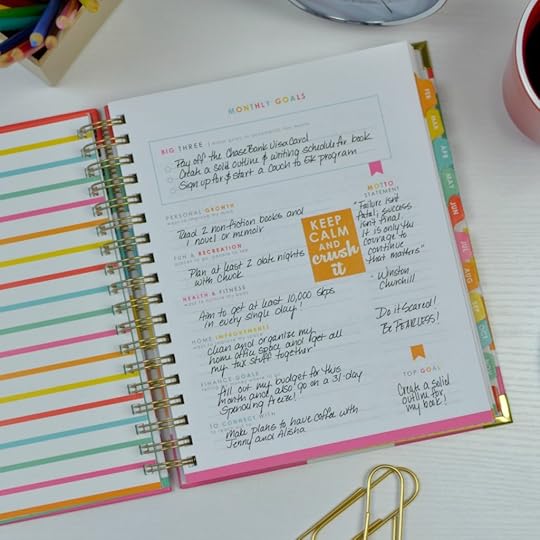 STEP TWO: Set Specific Goals
STEP TWO: Set Specific GoalsClose your eyes and imagine your life in detail five years from now. Where do you live? Where do you work? What is your job title? What do you look like? What does your house look like? How much money do you have in the bank? Where did it come from? What is your relationship with your kids and spouse? How do you spend time together? What do you do in your free time? What are your hobbies? Where do you volunteer? Spend a few minutes day-dreaming about what your ideal life would look like five years from now, then write it down.
With this vision of the distant future fresh in your mind, it is time to set your long term goals. List five major things you would like to accomplish by this time next year. Be as specific as possible. Use dates and locations and quantifiable goals whenever possible. Thus, if you want to run a marathon, write down which marathon on what date. If your goal is to read more, write down how many books, or better yet, how many fiction, non-fiction, biography, etc. Don’t list more than five or you might forget some of them.
With your long term vision and goals in place, give some thought to your short term goals. What is it that you want to get done in the next month? Is there any small chunk of your long term goals that you could do right away? Set a few manageable goals for the things you would like to accomplish in the next month, then repeat this process every month from now on.
One useful tool for putting this method of goal setting into practice is our Living Well Planner, which includes pages for setting both long-term goals for the year, as well as setting monthly goals. I have found that having this daily reminder of my biggest goals right in front of me helps keep me motivated all year long!
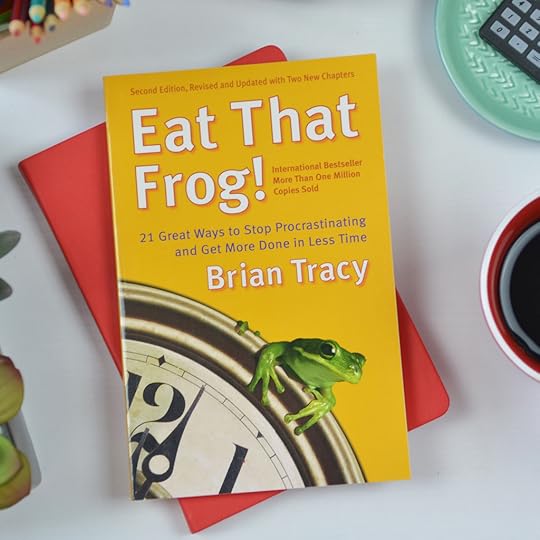 STEP THREE: Eat That Frog
STEP THREE: Eat That FrogOne of my favorite time management books of all time is called Eat That Frog: 21 Great Ways to Stop Procrastinating and Get Things Done by Brian Tracy. It got its name from a quote by Mark Twain, who famously once said something to the effect of “if you eat a frog for breakfast, chances are that will be the worst thing you have to do all day.” The point of the quote—and the book—was that if you start your day by tackling your hardest but most important tasks, even if you don’t do that much for the rest of the day, you will still have accomplished a lot.
Life moves fast and it is really, really easy to get sucked into mundane–though essential–tasks of the everyday. We spend our time putting out fires or escaping into the time-wasting vortex of social media and email. It all seems so important, so urgent, but before we know it, we’ve spent the whole day reacting to other people rather than proactively reaching our own goals.
My own life changed dramatically when changed the order in which I completed my task list. Most importantly, I stopped checking email first thing in the morning, and instead focused those first few hours of my day on long-term projects and goals. As a result, my productivity skyrocketed and I was finally able to start accomplishing the things I really wanted to.
The easiest and most simple way to make sure you are always focusing on your biggest tasks first is to divide your to-do list into A tasks—those most important tasks that will get you closer to your goals, B tasks—those items that should be done, and your C tasks—those things you would LIKE to do—and then to be vigilant about completing them in that order.
 STEP FOUR: Reset Your Habits
STEP FOUR: Reset Your HabitsAnother one of my favorite books is called The Power of Habit: Why We Do What We Do in Life and Business by Charles Duhigg. The book explains that our brains are wired to form habits. These habits can become good or bad, but once something has become a true habit, a different part of our brain takes over and we begin to perform that particular habit on autopilot. This means we no longer have to use mental energy to perform the task, which leaves our brain free to focus on getting other things done.
Because our willpower on any given day is a finite resource, the more good habits we are able to create for ourselves, the more willpower and energy we will have left over to use towards other things.
Creating a simple morning routine that allows you to start your day off right is a great way to put this into practice. It allows you to set the wheels in motion for a highly productive day, and once you get into the routine of doing the same thing every single morning, your brain doesn’t have to think about it anymore. Likewise, a simple evening routine can set you up for success the following day!
 STEP FIVE: Eliminate the Unessential
STEP FIVE: Eliminate the UnessentialGetting rid of the things we don’t really need to be doing is probably the hardest part of managing our time! After all, each of us has a few time fillers we could probably stand to eliminate, whether it playing Candy Crush on our phone, spending an hour watching TV or drooling over Pinterest, or even taking on a few too many commitments.
This is where the priority list and goal setting becomes so important! If when you look at your day, you find that much of your time is filled with things that don’t match up to your priorities or your most important goals, then something has to give. Start small–eliminate 3-5 things in your life that are taking up time but not adding much value. Just stop doing them. Yes, I know it is easier said than done, but making a conscious decision paves the way for change.
With just a few purposeful tweaks, you can learn to better manage your time so that it doesn’t manage you. In the end, it all comes down to learning how to focus on those few things that are most important and eliminate the rest.
* * *
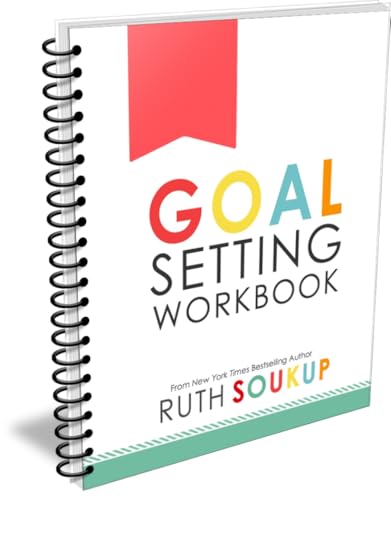 Of course these five simple steps will only help you take back your time and allow you to create a life you love if you are willing to put them into practice. That’s why we’ve created a practical (and FREE) guide that will walk you through all five of these steps quickly and easily. To get this life-changing 18-page Goal Setting Workbook sent instantly to your inbox, simply click the button below.
Of course these five simple steps will only help you take back your time and allow you to create a life you love if you are willing to put them into practice. That’s why we’ve created a practical (and FREE) guide that will walk you through all five of these steps quickly and easily. To get this life-changing 18-page Goal Setting Workbook sent instantly to your inbox, simply click the button below.
Pin It
The post How to Take Back Your Time in Just 5 Simple Steps appeared first on Living Well Spending Less®.
July 22, 2016
8 Mommy Date Ideas

This is a guest post from Elaine of RadicalChristianWoman.com
The beginning of the school year is a mass of paperwork, new school supplies and excitement. The middle of the year is a gift-giving holiday feast. After Spring Break, children are looking forward to summertime freedom where soccer, summer camp and vacations abound.
Behind every child is an amazing mom working hard at juggling all of these activities for her children.
If you are anything like me, sometimes I forget to slow down the hustle and bustle and just be with my children. All too often, my time tends to get sucked up by the urgent calling of whatever chore needs to be done, reducing the relationship between my children and I to a flurry of events that lack the depth I desire.
Meaningful “mommy dates” with our kids don’t have to be elaborate or even a long time commitment, it can be done in the 30-minutes before bed or when you are out on errands.
The biggest trick about “mommy dates” is that you announce it’s arrival like you would announce Cinderella at the ball. Perception is 9/10ths of the rule when it comes to children, so making a big deal about spending time with mommy is very important.
If you are at a loss for potential “mommy date” ideas, here is a list to help you start your brainstorming. If you have any other ideas, I’d love it if you commented below!

1. Having a Show
My husband and I love watching TV shows together. For many couples, it’s a weekly tradition that we look forward to, so why not extend it to our children?
My daughter and I watch Gilmore Girls together. Throughout the week we can reference the quirky things Rory and Lorelei say. Having those “inside jokes” bonds us together and makes us laugh.
Choosing a show that is age-appropriate but that you both like is the key to the longevity of this “mommy date.” If you both aren’t into the show, that special connection is lost.
2. Weekly Shopping Trip
Who says you can’t kill two birds with one stone when it comes to “mommy dates?” A weekly shopping trip is a great way to connect while getting some facetime with your kid.
It’s easy to slip into “shopping” mode with this idea so you have to make a special effort to keep it “mommy-date” focused by actively engaging with them. It might make for a longer shopping trip, so I like to buy a special treat for both of us before we begin. Nothing big, usually a coffee for me and a special drink for my date!

3. Go for a Walk or a Drive
Not being face to face, like when walking or driving, allows conversation to freely flow between a mom and her child. Children aren’t hindered by our facial expressions where they might adjust their words according to what they think we want to hear. Often we experience the best conversations in these situations, like taking a walk or a long drive.
Random comments about a flower on the side of the road or a landmark might spark conversation we might not otherwise have had allowing us to get to know each other better.
4. Playing a Game
Board games, XBOX or cards, game playing is a fun (and inexpensive) way to connect.
After introducing a great card game called Phase 10 to my second oldest daughter, she’s addicted. She taught all of her friends to play, proving that the influence of “mommy dates” doesn’t just stop at our own relationship with our own children.
For younger children, simple games like a verbal “Guess Who?” game is always fun.
How to Play Verbal “Guess Who?”
Think of a person that your child knows.
Depending on their age, think of a clue that will intrigue them to guess who you are describing.
Say: “I’m thinking of a person who [insert clue].”
Repeat Step 3 until they guess the person.
Reverse roles.

5. A Special Project
Working on a special project with your children can be a great way to unite together under a common purpose.
One time, my daughter had an idea for a book. For weeks we sat on my bed and outlined each scene. As I wrote it, she’d read each chapter and made suggestions. This special project allowed us to connect with my passion for writing with her fabulous concept. Whether or not it ever gets published, we will always have memories of writing a novel together. A special project doesn’t have to be elaborate or extraneous. It can be doing something simple and needful, like making dinner together.
Tips for Having Fun When Collaborating on Special Projects
Avoid “taking over.” Let your child learn by experimenting.
Don’t freak out about the mess.
Verbalize your enjoyment. Children love to hear, “I’m having so much fun doing this special project with you!”
6. Sharing a Meal
Dinner dates aren’t just for romance, you can treat you and your child to a meal at your favorite restaurant. If dinner is too difficult, surprising your child at the schoolroom lunch table is a fun way to spend time with your kid (and their classmates). You can also plan an semi-elaborate meal at home if money is an issue. My kids love home-cooked dinners over candlelight. Remember that unlike a romantic dinner with your husband, part of sharing a meal with your kids doesn’t have to include that “I did it all by mysellf!” element. Let them help!
Fun Ideas For Planning a Fun “Romantic” Mommy Date Dinner
Suggest that your child go off and make “secret” decorations.
Use electric tea lights for a safe “candlelight” experience (or you could put flashlights in a flower vase).
Use the good stuff. Don’t let those fancy dishes go to waste. (This is a great time to teach your child the techniques on how to handle things carefully.)
If you aren’t ready to use your fine china, put their plastic tea set to good use…as least for dessert!
Look up some tips on manners and lift those pinky fingers high!

7. Old Experiences
I remember visiting an authentic Japanese restaurant with a friend when I was a teenager. We took our shoes off and sat cross-legged at traditional low-lying Japanese table. I watched the Koi fish swim in a pond as we were served sushi by women in traditional Japanese attire. It was a blast.
When I had a chance to share this old experience with my child I got to experience it afresh through their eyes! If you have something that you remember doing as a child, give it new legs by introducing it to your own children. Don’t forget to share the story about when you did it!
Beware: Your children may not love it the way you did, but that’s okay. The point isn’t that they love it, but that you bond over the experience.
8. New Experiences
Is there something you’ve always wanted to do, but haven’t had the guts to try alone? Do it with your kid! Children will get a kick out of being “the first” one to do something new with mom!
A Few New Experiences You Could Do With Kids
iFly – Indoor Skydiving
Having a Booth a Local Festival
Entering a Contest
Singing for a Crowd
Starting a Club
Final “Mommy Date” Tips
Finally, just like regular dating, going on a “mommy date” should be fun for both parties involved. It shouldn’t be a chore or stressful. “Mommy dates” are there to serve your relationship with your children, not the other way around. If it’s not fun, stop and just enjoy your children in day to day life without the pressure to do anything more than be the amazing mom you already are!
Elaine is an author, blogger and speaker.
She’s written three books: Thriving the First Days of Becoming Mommy, How to Start a Christ-Centered Blog and has recently released her first novel, Without Regret. She writes on her blog at RadicalChristianWoman.com. Elaine lives in the suburbs of Austin, Texas with her husband Noah and her six children.
Pin It
The post 8 Mommy Date Ideas appeared first on Living Well Spending Less®.
July 20, 2016
Easy Greek Salad

I don’t know about you, but when the weather starts heating up I would do almost anything to avoid having to actually cook! I want foods that are fresh and easy and can come together in less than ten minutes. This easy Greek salad is the perfect solution to my lazy summer cooking style. Not only is it absolutely delicious, it requires simple and fresh ingredients. It is perfectly yummy all by itself, but it is also great served with grilled chicken or shrimp for an effortless meal your whole family will love!
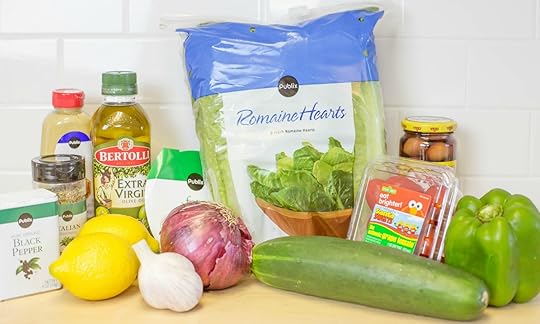
Here is what you need:
1-2 heads romaine lettuce, washed, dried and chopped
12oz. jar Greek black olives, pitted & sliced (*regular black olives can be used as well)
1 green bell pepper, chopped
1 pint cherry or grape tomatoes, washed
1 large cucumber, peeled, seeded and chopped
1/2 red onion thinly sliced
4 ounces feta crumbles
Dressing
1/2 cup olive oil
2 lemons juiced
2-3 cloves garlic, chopped
1 teaspoon Italian seasoning
1 teaspoon black pepper
2 tablespoons Dijon mustard

Step 1: Make dressing; whisk together olive oil, lemon juice, chopped garlic, Italian seasoning, black pepper and Dijon mustard until blended. Set aside.

Step 2: Chop lettuce and pepper and set aside.

Step 3: Peel cucumber, seed it and chop; set aside.
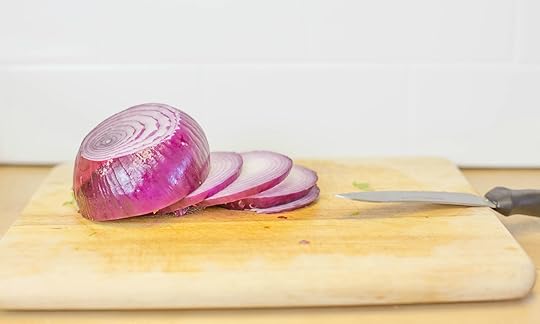
Step 4: Cut thin slices of red onion; set aside.

Step 5: Wash tomatoes and set aside. Then pit olives,chop and set aside.

Step 6: In large bowl; combine lettuce, peppers, tomatoes, olives, red onion, and cucumber . Mix dressing again and toss with salad. (* Note: If not serving salad right away, reserve salad dressing in small mason jar and store in fridge until needed.)

Step 7: Add feta to top of salad and serve.
Print This!
Recipe: Easy Greek Salad
Summary: This super easy and delicious salad is the perfect solution to dinner any time!
Ingredients
1-2 heads romaine lettuce, washed, dried and chopped
12oz. jar Greek black olives, pitted & sliced (*regular black olives can be used as well)
1 green bell pepper, chopped
1 pint cherry or grape tomatoes, washed
1 large cucumber, peeled,seeded and chopped
1/2 red onion thinly sliced
4 ounces feta crumbles
Dressing
1/2 cup olive oil
2 lemons juiced
2-3 cloves garlic, chopped
1 teaspoon Italian seasoning
1 teaspoon black pepper
2 tablespoons Dijon mustard
Instructions
Make dressing; whisk together olive oil, lemon juice, chopped garlic, Italian seasoning, black pepper and Dijon mustard until blended. Set aside.
Chop lettuce and pepper and set aside.
Cut thin slices of red onion; set aside.
Wash tomatoes and set aside. Then pit olives and set aside.
In large bowl; combine lettuce, peppers, tomatoes, olives, red onion, and cucumber . Mix dressing again and toss with salad. (* Note: If not serving salad right away, reserve salad dressing in small mason jar and store in fridge until needed.)
Add feta to top of salad and serve.
Preparation time: 5-7 minutes
Number of servings (yield): 6-8

Pin It
The post Easy Greek Salad appeared first on Living Well Spending Less®.
July 18, 2016
When Water Won’t Cut It

It’s pretty easy to take water for granted. In fact, here in the United States, it is something we don’t even have to think about. We simply turn on the faucet and water comes out, fresh, clean and ready to drink. It’s sometimes hard to even fathom that for more than a billion people in the world, clean drinking water is a luxury, and access to it is a daily struggle.
Even so, if you are anything like me, there are probably times when you don’t think about water often enough—and perhaps even times when you forget to drink it at all! But the benefits of water go far beyond hydration. Here are eight reasons to drink more water, and a few ideas for sneaking more water into your day.
8 Benefits of Water
Drinking water has many amazing benefits. Our bodies are made up of about 60% water so it’s critical we maintain hydration for good health. Dehydration is very serious and even slight dehydration can lead to increased appetite, moodiness and exhaustion. It’s recommended you get between 7-9 glasses (8 oz) of water per day to keep everything functioning properly, so it’s vital you drink up!

1. Clearer Skin
Drinking plenty of water can help keep your skin clear and bright. It helps your skin cells stay hydrated, giving you a younger, less dry appearance. Water helps with cell turnover, which helps keep your skin free of blemishes. Your skin is your body’s largest organ and water is essential for proper function of all organs.
2. Better Kidney Function
Just like your skin, your kidneys rely on water to help flush toxins out of your body and keep things running smoothly. Water helps prevent UTIs and kidney infections. When you’re dehydrated, your kidneys can suffer greatly, so it’s vital you stay hydrated to keep them functioning properly. Check your hydration levels by the color of your urine, which should be pale yellow (or even clear). Dark yellow or brown urine is indicative you aren’t getting enough water.
3. Better Focus
Yes, water helps your kidneys and skin, but it also helps another one of your most important organs: your brain. People who are hydrated have better concentration and focus. Your brain cells are able to process information more efficiently, resulting in better recall and mental clarity.

4. Weight Loss
It’s no secret water helps with weight loss, which is why we so frequently see it recommended by health magazines, personal trainers and weight loss consultants. Drinking cold water can even help (slightly) boost your calorie burn. Water can help you feel fuller if you drink a glass before meals, making it easier to pass up second helpings or dessert.
5. Aided Digestion
Water also helps keep everything “moving” in a proper manner. If you have issues with constipation and regularity, water and dehydration might be something to look into and address. Water helps food move through your body, and just like your skin, brain and kidneys, it helps your digestive organs do their jobs properly and efficiently.
6. Fewer Muscle Strains & Better Joint Health
Water keeps your joints lubricated and moving. It can keep your muscles from feeling strained by keeping electrolytes, potassium, and sodium levels regulated. Changes in these levels can lead to cramps and strains, and even injury and damage. Hydration during exercise is especially critical as your body sweats, depleting your water levels.

7. Fight Fatigue
If you feel tired or run down, or if you have frequent headaches, it could be due to dehydration. Often people don’t notice their mood and energy levels shift when they experience a lack of critical moisture. Keep yourself properly hydrated to boost energy levels and keep yourself going all through the day.
8. Money Savings
While your wallet might not be as important as your kidneys and joints, opting for water is one way to keep your cash flowing as well. It’s no secret that sodas and alcohol can add an extra premium to your bill whether you’re at a game, an amusement park, or out at restaurant. Opting for water or bringing your own refillable bottle of water in (which is often allowed) can help save you several dollars a day (at least)!

But I Don’t Like Plain Water….
So, what do you do when water just won’t cut it? Sometimes a glass of water just tastes too darn…well, bland. It’s certainly not as fun to drink water on the beach as it is to drink a margarita. (Although, keep in mind salt and alcohol do not mix well with heat if you’re looking to avoid dehydration!)
All in all, water can be pretty boring. Here are a bunch of great ways to spruce up your water and be sure you’re getting enough hydration this summer and beyond!
Warm Water
Not as exciting as hot chocolate, green tea or coffee, but sometimes water goes down a little easier if it’s warm. Sipping a cup of warm water can help you relax and slow down. It doesn’t have to be scalding hot, but gently warmed water can be something a little different, sip-able, and great for unwinding in front of a movie or while reading the news in the morning.
Ice Water
Just like warm water, changing up the temperature can make all the difference. Add ice or keep a pitcher in the fridge for cold and refreshing water that feels a bit more “special” and less like a chore. Try working your way through a cup of ice cubes if you’re the kind of person who likes to really savor something or if you tend to eat out of boredom.

Herbal Teas
Herbal teas are usually decaffeinated and they add a little flavor and excitement to your plain old water. You can enjoy lemon verbena, dandelion, burdock, and a myriad of fruit flavors from plum to strawberry to orange blossom. Places like Teavana offer gourmet flavors, but most grocery stores offer a wide selection of various teas. Try using a tea infuser and going for loose tea to really make it an experience. You can also make great herbal iced teas or use the tea to make low-cal, refreshing ice pops!
Infused Waters
Infusing water is very popular right now and for good reason! It’s a great way to get enthused about drinking water. You can purchase special infuser bottles that offer methods for adding fruit and herb flavors right to the water as you drink. You’re only limited by your imagination! To get started, try picking a fruit or veggie and an herb and adding it to your water (or go for several).

Try some of these fun combinations…
Strawberry and basil.
Raspberry and mint
Cucumber and Tarragon
Lemon and cinnamon
Orange and cayenne
Mango and white peppercorns
Apple and ginger
Blueberry and lemonbalm
Grapefruit and Thyme
Watermelon and spearmint
Cantaloupe and Cilantro
Peach and Parsley
Lime and Rosemary
Cherry and sage
Pineapple and Stevia
Pear and Hyssop
Kiwi and Chamomile
Essential Oil Infusions
As long as you’re using 100% pure, therapeutic-grade essential oils (such as Young Living), you can take them internally by adding a drop or two to a glass of water. Peppermint water can be very soothing to your stomach and aid in digestion. Lemon can add a boost of energy and lavender may help you feel calm and relaxed. Citrus oils don’t react well with plastic, however, so be sure to always use glass or steel containers when you add oils to your water.
Seltzer
Seltzer is a great way to increase your hydration without adding calories or chemicals to your diet. Most seltzers (like LaCroix) are naturally flavored and come in varieties like peach, coconut, lemon and lime. You can even find flavor combinations like blackberry cucumber or strawberry lime. Pour it in a pretty glass, add a lemon or lime twist, and you’ll feel just as fancy as if you were enjoying a cocktail!
Raw Fruits & Veggies
Most fruits and vegetables have high water content and can help boost your hydration levels. Cucumber, lettuce, grapefruit, zucchini, watermelon and grapes are all great options to help you add a little more hydration in your life. Enjoying a yummy dish of melon can seem a lot more fun than just drinking a plain old glass of water!
Broths and Soups
Enjoying soups, particularly of the broth-based variety, can help you stay hydrated as well. Just keep in mind that many soups are very high in sodium. Consider making your own vegetable broth or stock to control the sodium levels and to use as a base for soups and meals.

How To Drink Even More Water!
Check out these four ways to keep water on your radar and help you reach your 7-9 (8 oz) glasses a day, every day.
1. Make a Goal
Just as you would with any goal, make it Specific, Measurable, Attainable, Relevant and Timely (SMART). Set your hydration goals in increments: Drink 1 cup in the morning at 6 am, another by 9 am, another at noon, and so on. By being specific about times and amounts, your goal can seem easily doable. Make drinking water a regular habit and soon it will become easy.
2. Get a Water Bottle
Get a water bottle you’re excited to use and keep it with you. Put it on your desk, carry it in your bag, and bring it in the car. Watch for BPA-free bottles with a wide mouth so they’re easy to clean. Bottles made of tempered glass or stainless steel are nice choices because they’re pretty indestructible. Whatever you go for, get something you’ll be happy to carry around with you wherever you go.

3. Set an Alarm
If you have a hard time remembering to drink regularly, consider setting an alarm on your phone or set a timer. Make it a habit to drink at mealtimes and then set a gentle reminder to pop up in the morning and afternoon. A friend of mine has a Post-it stuck to her computer monitor that simply reads, “Drink Water.” Every time she looks at it, she takes a sip. Simple! Not only will setting up a reminder help you keep drinking and stay hydrated, but also, if you work at a desk, it can be a nice reminder to get up, walk around and take a break from your computer for a moment.
4. Keep Water Handy
The biggest key to remembering to drink regularly is to just keep water around. Keep it on your desk, in your bag, and in your car. When you’re at a restaurant, ask for a carafe at the table. Fill a pitcher with fruit and water and put it in your fridge, right in the front, so you’ll be reminded every time you open the door. Keep an empty glass on your nightstand and near the sink, so you can get in the habit of taking a drink when you wash your hands or go to bed.
Hydration is so important. So, even though it’s challenging to get enough water (and sometimes hard to be excited about doing it), it’s something necessary to all life. While you’re thinking about and exploring water, consider how lucky we are to have access and options when it comes to drinking. Support charities that are addressing our global water shortage and helping bring safe and clean drinking water to areas in need. Look into ways you can conserve and be mindful of water usage and waste. It is, after all, the very foundation of life on this planet.

The post When Water Won’t Cut It appeared first on Living Well Spending Less®.







